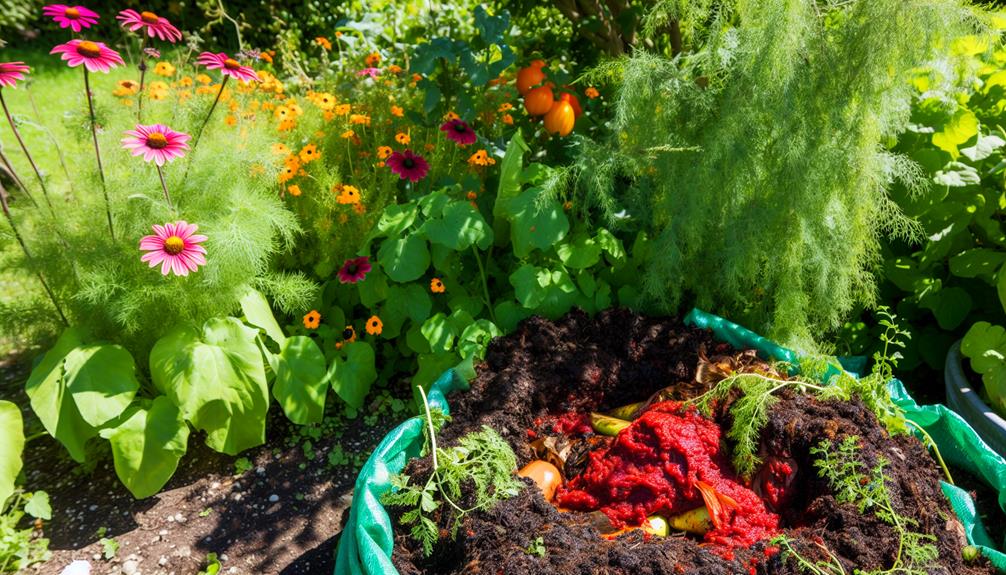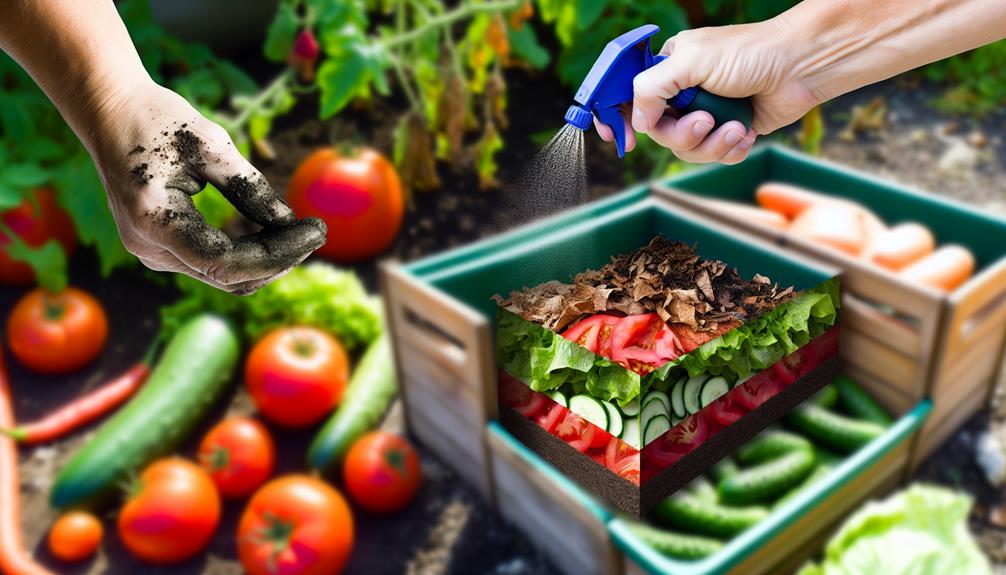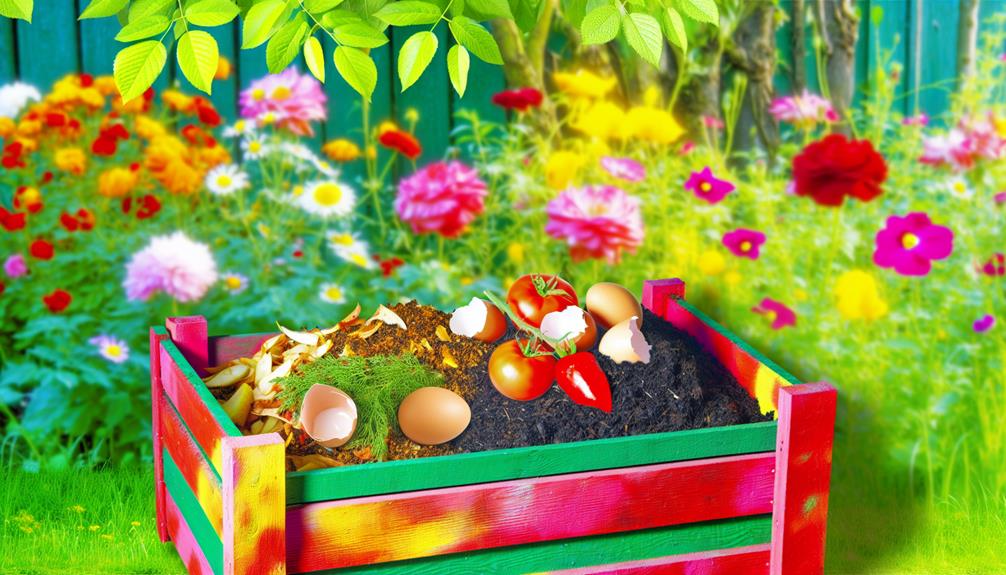

You can compost tomato puree, and it’s a great way to enrich your compost with valuable nutrients. Just be sure to maintain it with carbon-rich materials like dry leaves or newspaper to offset its high moisture content. The acidity in tomato puree won’t harm your compost if you manage it properly.
Guarantee your compost pile has good aeration and moisture levels to avoid a soggy mess. By keeping the right balance and conditions, you’ll turn your tomato puree into nutrient-rich compost that benefits your garden. There’s more to contemplate for prime composting.
Tomato puree, made by cooking and straining tomatoes, serves as a versatile ingredient in many recipes. To get the most from your tomato puree, it’s important to understand the different tomato types and processing methods.
Varieties like Roma or San Marzano are ideal for making puree due to their dense flesh and lower water content. These tomatoes yield a thicker, richer puree that’s perfect for soups, sauces, and stews.
When it comes to processing methods, you’ve got a few options. Start by washing and coring the tomatoes, then cut them into chunks. Cooking them on low heat until they break down is essential. You can use a food mill or a fine mesh strainer to achieve a smooth consistency. Some people prefer using a blender, but you’ll need to strain the puree afterward to remove seeds and skins.
Making your tomato puree at home allows you to control the ingredients and avoid preservatives found in store-bought options. It also brings a sense of community and belonging, knowing you’re crafting something from scratch.
Starting a compost pile at home is an excellent way to recycle kitchen scraps and enrich your garden soil. Composting benefits include reducing waste, lowering landfill contributions, and creating nutrient-rich soil.
To get started, choose a composting method that fits your lifestyle and space. Popular methods include traditional compost bins, tumblers, and worm composting (vermicomposting).
Begin by layering your compost pile with a mix of green and brown materials. Green materials, like tomato puree and vegetable scraps, provide nitrogen. Brown materials, such as leaves and cardboard, supply carbon. Aim for a balanced ratio of greens to browns, roughly 1:3, to speed up the decomposition process.
Keep your compost pile moist, but not soggy, and turn it regularly to aerate and mix the materials. This helps to maintain an ideal environment for microorganisms that break down the organic matter.
Be patient, as composting can take several months depending on the method and conditions.
Also Read: Can You Compost Celery?
Harnessing the nutrient benefits of composted tomato puree can greatly enhance the fertility and health of your garden soil. Tomato puree is rich in several essential nutrients, including potassium, magnesium, and vitamins A and C. These nutrients are crucial for plant growth and can help improve the overall health of your garden ecosystem.

By adding composted tomato puree to your garden, you’re not just recycling kitchen waste; you’re enriching your soil with a natural fertilizer. This can lead to healthier plants and a more bountiful harvest. The health benefits extend beyond the garden, as consuming nutrient-rich produce supports your well-being.
Tomato puree’s culinary uses are vast, from sauces and soups to stews and dips, making it a staple in many kitchens. By composting tomato puree, you guarantee that none of this valuable resource goes to waste.
To incorporate tomato puree into your compost, mix it thoroughly with other compost materials like leaves, grass clippings, and vegetable peels. This balance helps maintain the compost’s structure and nutrient profile.
While composted tomato puree offers numerous nutrient benefits, you must also address its natural acidity to guarantee a balanced compost. Tomato puree has high acidity levels, and if these aren’t managed, they can disrupt the pH balance of your compost pile. This imbalance can hinder microbial activity, slowing down the decomposition process.
To handle this, start by monitoring the pH levels of your compost. A balanced compost pile ideally maintains a pH between 6 and 8. You can use pH testing kits available at garden centers to check this. If you find that the acidity levels are too high, pH adjustment is necessary.
One effective method for pH adjustment is adding alkaline materials like crushed eggshells, garden lime, or wood ash. These materials help neutralize the acidity, bringing the pH closer to the desired range. Be mindful of the quantities you add, as too much can swing the pH too far in the opposite direction.
Also Read: Can You Compost Basil?
Proper moisture management is essential to guarantee that your composted tomato puree breaks down efficiently. Too much moisture can lead to a soggy, smelly mess, while too little can slow down the decomposition process. Tomato puree, given its culinary uses, naturally contains a lot of water, so you’ll need to balance this with dry materials like leaves, straw, or shredded paper.

Start by assessing your compost’s moisture level. It should feel like a damp sponge—moist but not dripping. If it’s too wet, add more dry materials and turn the pile to mix them in thoroughly. On the other hand, if it’s too dry, sprinkle some water over the pile and mix it well.
Storage methods for your tomato puree before composting can also affect moisture management. If you’ve stored it in a sealed container, it might be more watery than puree that’s been in an open container. Adjust accordingly by adding or reducing dry materials in your compost pile.
Balancing ingredients in your compost is essential for success. Aim for a proper carbon to nitrogen ratio by adding brown materials like leaves and straw to your tomato puree.
Guarantee good moisture and aeration to foster decomposition and maintain a healthy compost pile.
Achieving the right carbon to nitrogen ratio is crucial for creating a balanced compost with tomato puree. Tomato puree is rich in nitrogen, which means you need to balance it with carbon-rich materials to create effective compost. The ideal carbon to nitrogen ratio is about 30:1.
Here’s how you can achieve this balance:
Using tomato puree in compost is a great way to recycle kitchen waste, especially if you’ve stored too much or have leftovers from various cooking uses. When balancing your compost, remember that too much nitrogen can lead to a smelly, slimy pile, whereas too little can slow down the decomposition process.
To maintain an effective compost pile with tomato puree, make sure you manage moisture levels and provide adequate aeration. Tomato puree, with its liquid texture, can increase the moisture content of your compost pile, which is important for microbial activity. However, too much moisture can lead to anaerobic conditions, causing unpleasant odors and slowing down decomposition.
Start by evaluating the moisture level in your compost. It should feel like a wrung-out sponge—not too dry and not too wet. If it’s too wet, mix in drier materials, such as shredded paper or straw, to absorb excess moisture. Regularly turning your compost pile will help maintain proper aeration, ensuring that oxygen reaches all parts of the pile and supports aerobic bacteria.
Aeration is equally important. Without it, your compost can become compacted, especially with the dense, liquid texture of tomato puree. Turn the pile every week or so, using a pitchfork or compost aerator, to introduce air and prevent compaction. This will speed up the decomposition process and reduce the risk of foul smells.
You need to add brown materials like dried leaves, straw, or cardboard to balance the nitrogen-rich tomato puree in your compost pile. These brown materials provide carbon, which is essential for creating a well-balanced compost that breaks down efficiently. Without enough carbon, your compost may become too wet and start to smell, which isn’t essential for a community-driven compost project.
Balancing ingredients is vital for all compost types, whether you’re using a bin, pile, or tumbler. To achieve the right balance, follow this simple guidance:
When adding tomato puree to your compost, you’re enriching it with valuable nutrients. Be sure to balance this addition with plenty of carbon-rich materials like dried leaves or straw.
This helps maintain the right compost ratio and prevents any potential issues with excess moisture or odor.
Adding tomato puree to your compost pile is a simple way to enhance its nutrient content and promote healthier soil. Whether you have leftover puree from various cooking tips or need to use up excess due to improper storage methods, composting is a practical solution.
Tomato puree is rich in essential nutrients like nitrogen, potassium, and phosphorus, crucial for plant growth. When you add it to your compost, you’re enriching the mix, making it more advantageous for your garden.
Here are some quick tips to make sure you’re getting the most out of this nutrient-rich addition:
Incorporating tomato puree into your compost requires careful balancing of ingredients to maintain an ideal composting environment. Since tomato puree is rich in nitrogen, you’ll need to balance it with carbon-rich materials.
Think about your compost like a recipe. Just as you would with your culinary uses, you need the right mix to achieve the best results.
First, consider the preservation methods you’ve used for your tomato puree. If it’s fresh or homemade, it’s likely high in water content, which can make your compost too wet. Add dry, carbon-rich materials like shredded paper, straw, or dried leaves to counterbalance this moisture. Aim for a ratio of about three parts carbon to one part nitrogen.
Next, mix the puree thoroughly into the compost to avoid clumping, which can create anaerobic pockets and slow down decomposition. Regularly turn your compost to keep it aerated and guarantee an even breakdown of materials.
One major issue with composting tomato puree is its high moisture content, which can lead to a soggy compost pile. A waterlogged compost heap can disrupt the balance of microorganisms essential for decomposition.
Because tomato puree is often used in food preservation and various cooking techniques, it tends to have a concentrated consistency that’s rich in water content.
To avoid problems, you need to be aware of the following potential issues:
Also Read: Can You Compost Barbecue Sauce?
To successfully compost tomato puree, make sure you balance its high moisture content with dry, carbon-rich materials like straw or shredded paper. This helps maintain the right composting conditions, preventing a soggy mess and ensuring efficient decomposition.

When adding tomato puree to your compost, mix it thoroughly with other materials. This ensures that the puree doesn’t clump together, which can hinder airflow and slow down the composting process. A balanced mixture promotes a healthy microbial environment important for breaking down organic matter.
Consider the canning methods you’ve used for your tomato puree. If you’ve added any salts, sugars, or preservatives, be mindful that these can affect the composting process. Natural, unseasoned puree is best for composting.
Tomato puree also contributes to the flavor profiles of your compost. While this might seem odd, diverse inputs can enhance the nutrient quality of the finished compost, benefiting your garden soil.
Always monitor your compost pile’s moisture level and temperature. If it’s too wet, add more dry materials. If it’s too dry, sprinkle some water. Regular turning helps maintain airflow and even decomposition.
Following these tips will ensure your compost thrives, enriching your garden with nutrient-rich humus.
Yes, tomato puree can attract pests to the compost pile. However, you can use pest deterrents and compost covers to minimize this risk. Together, you and your fellow gardeners can maintain a healthy, pest-free compost.
Adding tomato puree to your compost pile can boost microbial activity, leading to a slight increase in temperature. This helps maintain nutrient balance and guarantees a more efficient composting process, making you a composting pro!
You’re curious about how long tomato puree takes to decompose. It depends on moisture levels and the overall decomposition rate. With proper moisture, it can take a few weeks, making you feel part of a thriving compost community.
For composting tomato puree, you can utilize anaerobic digestion or vermicomposting methods. These techniques help break down the puree efficiently. Just make sure you’re maintaining the right conditions, and you’ll be part of a great eco-friendly community.
Yes, you can compost tomato puree in cold climates! Embrace seasonal composting by insulating your compost bin and adding extra brown materials. You’ll help create a thriving community of microorganisms, even in chilly weather.
To sum up, you can compost tomato puree by managing its acidity and moisture. Balance it with dry materials like leaves or straw to prevent sogginess.
Monitor your compost for any signs of imbalance, such as unpleasant odors, and adjust ingredients accordingly. Regularly turn your pile to guarantee proper aeration and decomposition.
By following these steps, you’ll effectively recycle tomato puree into rich, nourishing compost for your garden.
